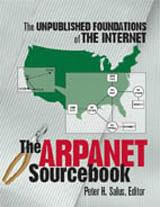A new study documents the origins of the Internet, including many handwritten original papers from ISI, an early center of development — documents located by the ISI Postel center.
The center’s director, Joe Touch, found archive copies of 17 of the earliest Requests for Comments (RFC)’s, the compositions that set the rules for the now ubiquitous network. The 17 included the very first RFC, and its six immediate successors. [see illustration from RFC 7, below].
The new collection they and many other materials appear in The ARPANET Sourcebook: Unpublished Foundations of the Internet, edited by Peter Salus, former Executive Director of USENIX and The Sun User Group and Vice President of the Free Software Foundation. The book is published by Dan Doernberg’s Peer- to-Peer Communications.
In addition to the Postel Center-provided documents, the book contains much more hard-to-locate material on the origins of today’s Internet.
Says Touch: “The compendium provides a unique resource of original material that led to the Internet.”
In addition to the documents provided by Touch were edited by ISI’s Jon Postel, namesake of the center Touch directs, the collection includes such landmark papers as Paul Baran’s original 1964 Rand Corp. report “On Distributed Communications,” that set forth the concepts of packet networking that are so ubiquitous today.
It also includes the 1968 report on “The Computer as a Communication Device” by J.C.R. Licklider and Robert Taylor, respectively the ARPANET’s earliest proponent and the ARPA administrator who pushed the development project.

The book has images of the first 18 RFCs, many handwritten, as well as a block of reports from BBN, providing diverse first-person accounts of the ARPAnet’s development and initial experiments.
The book also includes retrospectives from various timeframes, from the late 1960’s when the first packet exchanges occurred through today, by various contributors to the original architecture, which, together with the RFCs and papers, provide an invaluable perspective on the origins of internetworking.
The book is dedicated to USC/ISI’s Jon Postel, RFC editor since the series’ inception in 1969 through his passing in 1998, and for whom the Postel Center is named. The inscription concludes, “If you use the Internet, you are indebted to Jon”
“We could not agree more,” says Touch, adding that “we who explore Internet history are now indebted to Peter Salus.” Established in 2003, the Postel Center uses its endowment to continue work in the spirit of Dr. Jonathan B. Postel, internet pioneer.
Published on March 5th, 2008
Last updated on August 5th, 2021












